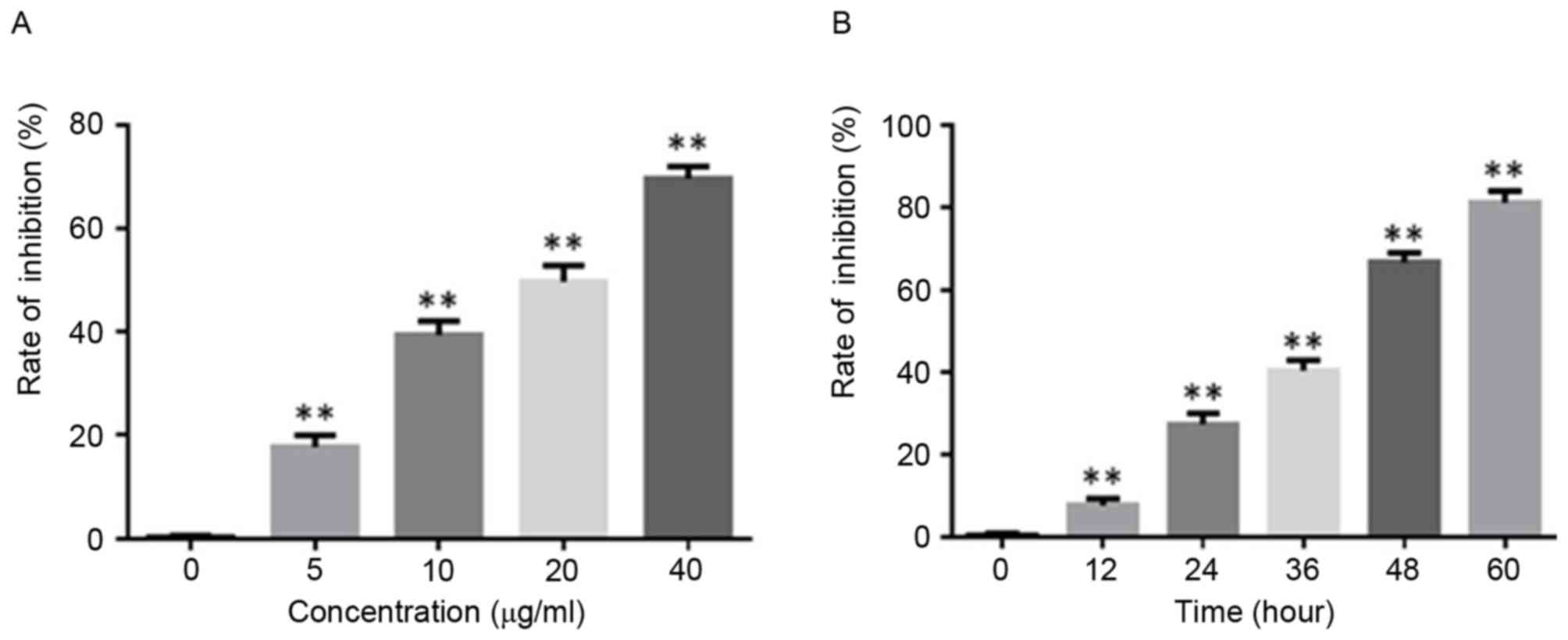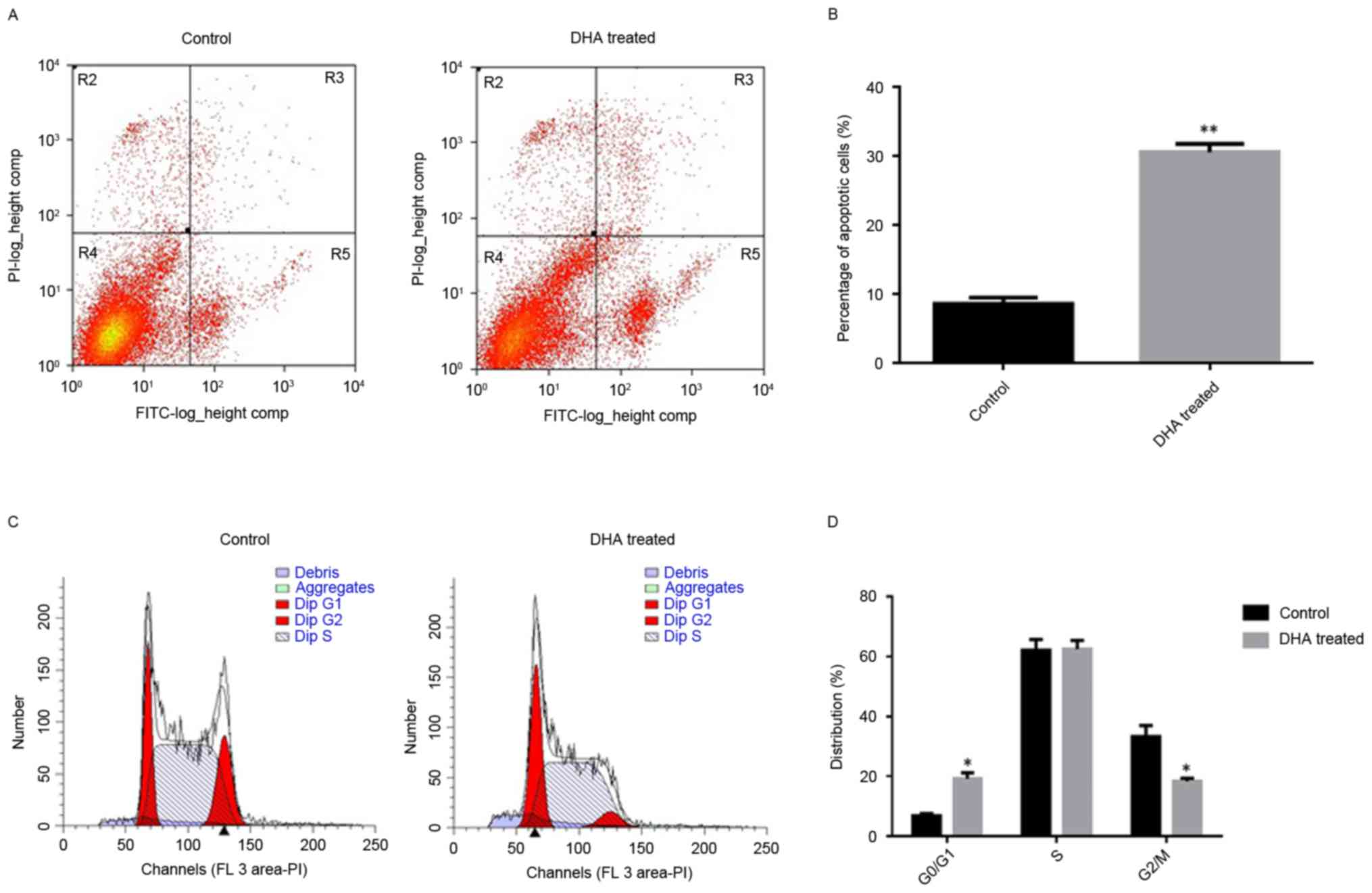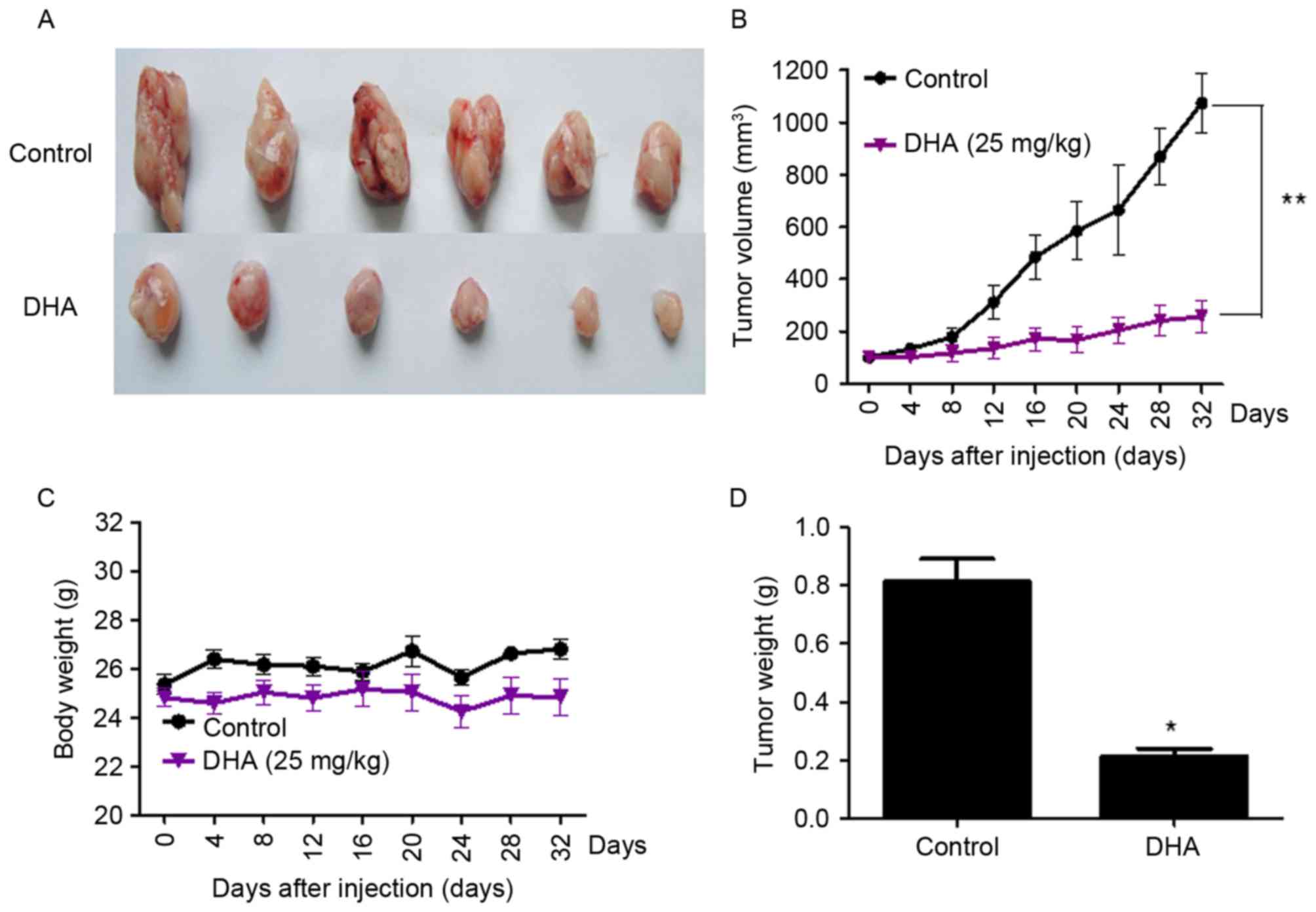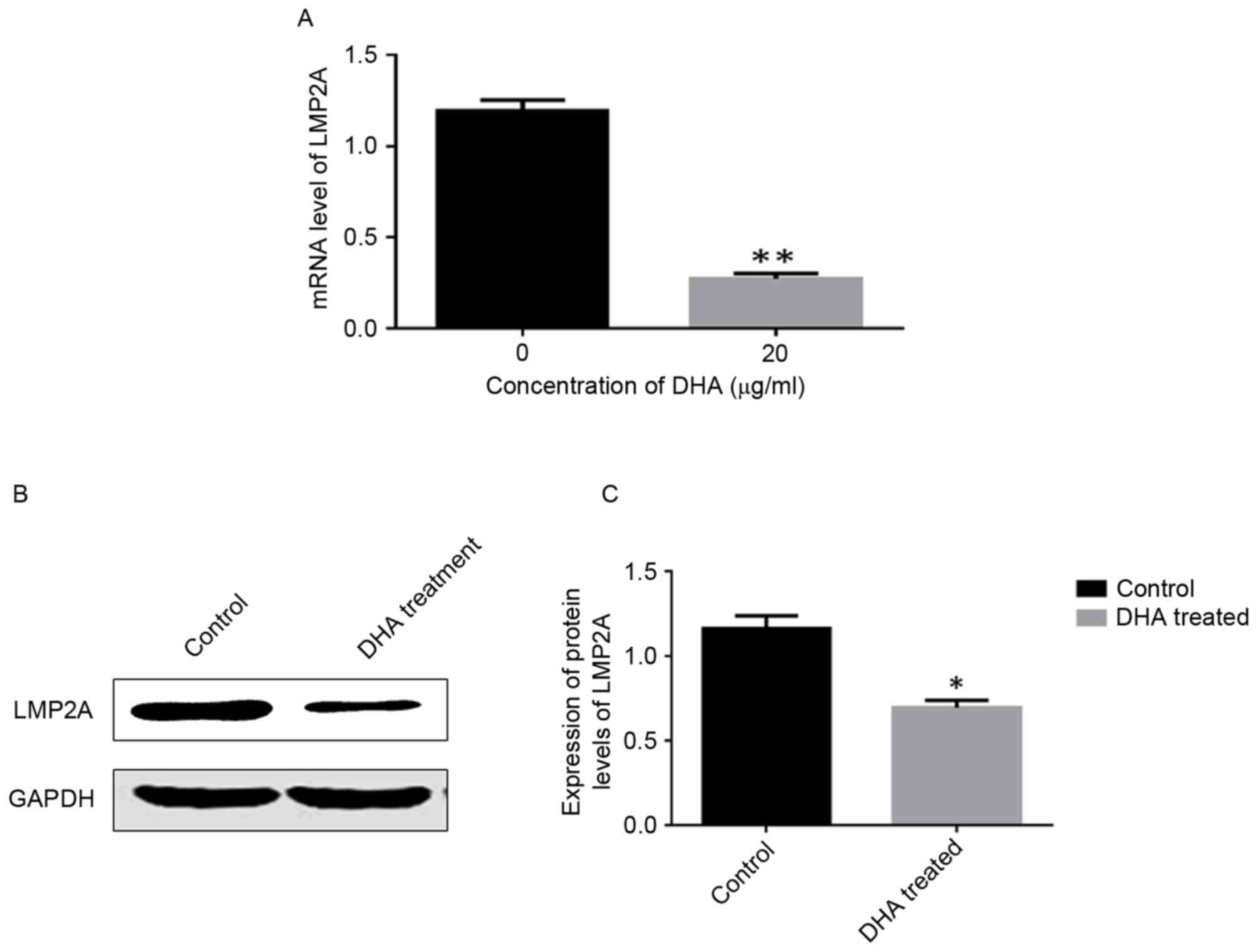Dihydroartemisinin suppresses the proliferation of Epstein‑Barr virus‑associated gastric carcinoma cells via downregulation of latent membrane protein 2A
- Authors:
- Published online on: June 12, 2018 https://doi.org/10.3892/ol.2018.8950
- Pages: 2613-2619
Abstract
Introduction
Epstein-Barr virus (EBV), a human γ herpes virus, may exist in humans for a long time without producing any symptoms (1). A variety of human malignancies, including Burkitt's lymphoma (2), nasopharyngeal carcinoma (3) and gastric cancer have been reported to be associated with EBV (4). EBV-associated gastric carcinoma (EBVaGC) has been reported to account for ≤10% of total gastric carcinoma (5). It is difficult to remove and eliminate EBVaGC cells thoroughly by surgical, radio and chemotherapeutic methods. Therefore, it is necessary to identify novel therapeutic approaches to treat EBVaGC by inhibiting tumor cell growth or survival.
At present, traditional Chinese herbs are widely being studied to treat numerous diseases (6,7). One herb, artemisinin, the active constituent of Artemisia annua L., along with its derivatives, has been used as an effective anti-malarial agent (8). Dihydroartemisinin (DHA), one of the main active metabolites of arteminisin, has been reported to exhibit antitumor activity in various cancer cells in vitro and in vivo in mice (9,10). DHA inhibits cell proliferation by inducing G1 arrest and apoptosis in human nasopharyngeal carcinoma cells. DHA, as a putative signal transducer and activator of transcription 3 (STAT3) inhibitor, suppresses the growth of head and neck squamous cell carcinoma by targeting Janus kinase 2/STAT3 signaling. DHA prevents breast cancer-induced osteolysis by inhibiting breast cancer cells and osteoclasts. DHA combined with holotransferrin, which increases the concentration of ferrous iron in cancer cells, was reported to effectively kill a type of radiation-resistant human breast cancer cell in vitro (11). However, there are few studies about the effect of DHA on EBVaGC.
EBVaGC expresses a well-defined set of latent viral genes, including latent membrane protein 2A (LMP2A). It was reported that LMP2A is expressed in ~50% of EBVaGCs (12). As a transmembrane protein, it functions in multiple signal transduction pathways and is involved in the tumorigenic processes in EBVaGC (12). LMP2A is associated with DNA methyltransferases and induces expression of phosphorylated-STAT3, which causes upregulation of DNA methyltransferase (DNMT)1 (13) and DNMT3B (14) in EBVaGC cells. Downregulating LMP2A may also inhibit apoptosis through upregulation of the cellular survivin gene via the nuclear factor-κB pathway (15). Therefore, LMP2A may be a potential target for treatment of EBVaGC.
In the present study, the effect of DHA on the growth of EBVaGC cells was explored and the LMP2A-associated mechanisms were investigated, with the aim of finding a potential candidate for EBVaGC therapy.
Materials and methods
Cell line and culture
The EBVaGC GT-38 cell line was purchased from the American Type Culture Collection (Manassas, VA, USA). Cells were maintained at 37°C in RPMI-1640 medium supplemented with 10% fetal bovine serum (MP Biomedicals, LLC, Santa Ana, CA, USA), 100 U/ml penicillin and 100 mg/l streptomycin in a humidified environment with 5% CO2.
MTT assay
GT-38 cells were seeded onto 96-well plates at 6×104/ml. No DHA was added to the negative control group; equal amounts of PBS were added instead, and 5, 10, 20 and 40 µg/ml DHA were added to the experimental groups of GT-38 cells for 48 h. Each group was repeated six times. A total of 20 µl MTT solution (5 mg/ml) was added to each well following 0, 12, 24, 36, 48 and 60 h of incubation at 37°C, respectively, and the plates were incubated for 4 h at 37°C. Dimethyl sulfoxide (DMSO; 100 µl) was then added to each well, and the plates were rotated for 15 min. The absorbance was measured at 450 nm with a microplate reader (SPECTRA MAX 190; Molecular Devices, LLC, Sunnyvale, CA, USA). The inhibition of cancer cell viability was calculated as follows: Inhibition rate (%)=(1-optical density (OD)treatment/ODcontrol) ×100.
Apoptosis assay
According to protocol of the Annexin V-FITC Apoptosis Detection kit (Sigma-Aldrich; Merck KGaA, Darmstadt, Germany), following treatment with 0 and 20 µg/ml DHA for 48 h, GT-38 cells were harvested by centrifugationat 500 × g for 5 min at room temperature, resuspended in binding buffer and successively incubated with 5 µl Annexin V-fluorescein isothiocyanate and 5 µl propidium iodide (PI) for 15 min at room temperature. A flow cytometer (FACS Calibur; BD Biosciences, Franklin Lakes, NJ, USA) was then used to analyze the apoptosis results.
Analysis of cell cycle by flow cytometry
Following pre-incubation with Dulbecco's modified Eagle's medium (Gibco; Thermo Fisher Scientific, Inc., Waltham, MA, USA) for 24 h, 0 and 20 µg/ml DHA was added to GT-38 cells for 48 h. The cells were centrifuged at 500 × g for 5 min at room temperature, fixed in 70% cooled ethanol, and then dyed with PI for 30 min in the dark. The cells were measured by a flow cytometer (FACS Calibur; BD Biosciences), and the data on the percentage of cells at each stage of the cell cycle was harvested.
Reverse transcription-polymerase chain reaction (RT-PCR)
Total RNA was extracted from groups of GT-38 cells, which were treated with 0 and 20 µg/ml DHA for 48 h, using TRIzol reagent (Invitrogen; Thermo Fisher Scientific, Inc.). Total RNA was then treated with DNaseI (Roche Diagnostics, Basel, Switzerland) to remove contaminating genomic DNA prior to the preparation of cDNA. Reverse transcription was performed using the cDNA Synthesis kit (Invitrogen; Thermo Fisher Scientific, Inc.) The following reagents were added into a sterile, nuclease free tube on ice in the following order: 1 µl total RNA, 1 µl Oligo (dT) 18 primer, 10 µl nuclease-free water, 4 µl 5X Reaction Buffer, 1 µl RiboLock RNase Inhibitor (20 U/µl), 2 µl 10 mM dNTP Mix and 1 µl RevertAid M-MuLV RT (200 U/µl). The total volume was 20 µl. The mix was incubated for 5 min at 25°C followed by 60 min at 42°C. The reaction was terminated by heating at 70°C for 5 min. cDNA (5 µl) from each sample was used to perform PCR. The sequences of primers for LAMP2A were as follows (13), forward: 5′-ATGACTCATCTCAACACATA-3′ (nt.166874-166893), reverse: 5-CATGTTAGGCAAATTGCAA-3 (nt.166380-166361). The product size of LMP2A was 280 bp. Glyceraldehyde 3-phosphate dehydrogenase (GAPDH) was used as a control, and the primers of GAPDH were as follows, forward: 5′-ACGGATTTGGTCGTATTGGG-3′ and reverse: 5′-TGATTTTGGAGGGATCTCGC-3′. The qPCR was performed with 1 µl cDNA using SYBR Green Taq Mix (Takara Bio, Inc., Otsu, Japan) on ABI PRISM 7500 Real-time PCR System (Applied Biosystems; Thermo Fisher Scientific, Inc.). The expression of target gene was evaluated using a relative quantification method (2−∆∆Cq) (16), with GAPDH as the internal reference. The thermocycling conditions were as follow: 95°C for 5 min, followed by 40 cycles of 95°C for 30 sec, 60°C for 30 sec and 72°C for 1 min, with a final extension step of 72°C for 5 min.
Western blot analysis
Protein was extracted from GT-38 cells treated with 0 or 20 µg/ml DHA for 48 h using radioimmunoprecipitation assay buffer (150 mM NaCl, 0.1% SDS, 0.5% sodium deoxycholate, 1% nonidet P-40 and 50 mM Tris pH 8.0) with the addition of 2 mM phenylmethylsulfonyl fluoride. Protein concentrations were determined with a The QuantiProbicinchoninic acid (BCA) Assay kit (Sigma-Aldrich; Merck KGaA), and 20 µg protein was loaded on 15% SDS-PAGE gels and then transferred to polyvinylidene fluoride membranes for western blotting. Membranes were blocked at 4°C overnight with 5% skim milk, and incubated with a 1:200 dilution of rat anti-EBV LMP2A antibody at 4°C overnight (cat. no. ab59028; Abcam, Cambridge, UK). The blots were washed with phosphate buffered saline (PBS) with 0.05% Tween-20 3 times and then incubated with a donkey anti-rat secondary antibody conjugated with horseradish peroxidase, diluted by 1:2,000 (cat. no. A18739; Thermo Fisher Scientific, Inc.).
In vivo tumor growth xenograft models
A total of 12 BALB/c-nude mice (4–6-week-old; male; SPF degree, and 20–24 g of body weight) were purchased from the Sino-British Sippr/BK Lab Animal Co., Ltd., (Shanghai, China). Animals were housed in a specific pathogen-free room within the animal facilities, and were maintained at the average temperature of 23°C and the relative humidity of 40–70% in a 12-h light/dark cycle. The access to the food was restricted. All animals were allowed to acclimate to their new environment for 1 week prior to the initiation of the model. Mice were randomly divided into 2 groups (6 mice/group). The animal use protocol was approved by the Institutional Animal Care and Use Committee of Xi'an Jiaotong University Second Affiliated Hospital (Xi'an, China). The GT-38 xenograft tumor model was developed by injecting a 5×106 GT-38 cell suspension into the right flank of the BALB/c-nude mice. Tumor nodules were allowed to grow to a volume of ~150 mm3 prior to initiating treatment. Tumor-bearing BALB/c-nude mice were randomly assigned to two groups and treated with 25 mg/kg DHA or DMSO. The tumor volume and total body weight were measured every 2 days. The tumor volume was calculated using the following equation: Tumor volume (V)=length × width × width × 0.52. These experiments were replicated 3 times.
Statistical analysis
The continuous variables are presented as the mean ± standard deviation. The statistical analysis was performed using Prism 5.0 software (GraphPad Software, Inc., La Jolla, CA, USA). The differences between the control group and experimental groups were determined by one-way analysis of variance (ANOVA) followed by a Student Newman-Keuls post-hoc test. As treatment and time course were investigated, two-way ANOVA followed by a Student Newman-Keuls post-hoc test was also used. P<0.05 was considered to indicate a statistically significant difference.
Results
DHA inhibits GT-38 cell viability
The MTT assay revealed that DHA inhibited the viability of GT-38 cells in a dose-dependent manner (Fig. 1A). With increasing concentrations of DHA, the absorbance at 450 nm decreased and the rate of inhibition increased (P<0.05; n=6; Fig. 1A). It was also observed that DHA exerted a time-dependent inhibition of viability in GT-38 cells (Fig. 1B). Following treatment with DHA for 0, 12, 24, 36, 48 and 60 h, the absorbance at 450 nm decreased and the rate of inhibition increased (P<0.05; n=6; Fig. 1B). Since there was no significant difference in cell growth inhibition between 48 and 60, 48 h was selected as the DHA treatment time for the subsequent experiments.
DHA treatment induces apoptosis and alters the cell cycle profile in GT-38 cells
Flow cytometric analysis revealed that the apoptotic rate was 6.25±0.38% and17.33±0.79% following treatment with 0 and 20 µg/ml DHA for 48 h, respectively (Fig. 2). The proportion of apoptosis was significantly increased in the 20 µg/ml DHA group compared with the control group (P<0.05; n=6; Fig. 2).
It was revealed that the proportion of G0/G1 phase cells was 19.15±1.28% following treatment with 20 µg/ml DHA for 48 h, while the proportion of G0/G1 phase cells was 6.75±0.37% in the control group. The present results also demonstrated that the percentage of G2/M phase cells was 18.33±0.49% subsequent to being treated with 20 µg/ml DHA for 48 h, while the percentage of G2/M phase cells was 31.15±1.78% in the control group (Fig. 2A and B). The frequency of GT-38 cells in the G0/G1 phase was significantly increased while the frequency in the G2/M was decreased following treatment with 20 µg/ml DHA, as compared with the control group (P<0.05; n=6; Fig. 2C and D). No significant difference was observed in the S-phase phase between the control group and the DHA treated group.
DHA treatment inhibits the growth of GT-38 cell-transplanted tumors in vivo
Subcutaneous tumors were observed in all nude mice (n=12) inoculated with GT-38 cells (tumorigenicity rate of 100%). Tumor-bearing mice treated with 25 mg/kg DHA exhibited a significant reduction in tumor volume compared with untreated mice. Tumor volumes were 1195.40±21.3 mm3 and 220.98±12.5 mm3 in untreated and DHA-treated mice bearing GT-38 tumors, respectively (P<0.01; n=6; Fig. 3). No significant changes of mice body weight between the control and DHA treated group were observed, which indicated that DHA treatment in vivo had no significant toxicity (Fig. 3).
DHA treatment downregulates LMP2A expression in GT-38 cells
The RT-PCR results revealed significantly lower LMP2A mRNA expression levels in DHA-treated cells compared with untreated cells (P<0.05; Fig. 4A). Western blotting results demonstrated that the protein expression levels of LMP2A were significantly lower in DHA-treated cells compared with control cells. (P<0.05; Fig. 4B and C).
Discussion
The morbidity and mortality of gastric cancer has decreased in developed countries due to improved prognosis for early stage cancer (17). However, it remains the second leading cause of cancer-associated mortality globally (17). EBVaGC comprised 10% of gastric carcinoma cases in 2014, which is estimated to exceed 75,000 cases/year across the world (18). Treatment of recurrent and metastatic disease remains a challenge, particularly in developing countries.
DHA, a semi-synthetic derivative of artemisinin isolated from the traditional Chinese herb A. annua, is used as a first-line anti-malarial drug with low toxicity (19). In previous years, artemisinin and its derivatives have been identified as a promising drug to induce cancer cell apoptosis and inhibit viral infection (20). It was reported that DHA may inhibit pancreatic cancer cells in vitro through downregulating the expression of proliferating cell nuclear antigen and cyclin D1, upregulating cyclin dependent kinase inhibitor 1 expression and inducing apoptosis by reducing the ratio of B-cell lymphoma-2 (Bcl-2)/Bcl-2 associated X protein and increasing the activation of caspase-9 in a dose-dependent manner (9). It was also reported that DHA inhibited pancreatic cancer cells in subcutaneous BxPC-3 xenograft tumors in mice (9). Furthermore, DHA may also inhibit cervical cancer cells by upregulation of kinase inhibitor protein, a suppressor of metastasis, and downregulation of Bcl-2 (10). In addition, Sun et al (21) reported that the proliferation rate and colony-forming abilities of gastric cancer cells were significantly suppressed by DHA, together with significant suppression of the expression of proliferation markers (proliferating cell nuclear antigen, cyclin E and cyclin D1) and the upregulation of p21 and p27. However, it remains unknown whether artemisinin and its derivatives work as growth inhibitors in EBVaGC cells.
The present study investigated the inhibitory effect of DHA on EBVaGC cells. The present data demonstrated that DHA significantly inhibited the viability of EBVaGC cells in a dose-dependent and time-dependent manner. This was in accordance with previous studies, which also demonstrated a dose-dependent and time-dependent inhibition of different types of cancer cell viability following DHA treatment (9–11). The present results also demonstrated that DHA significantly increased the apoptotic rate of GT-38 cells. The same cancer cell inhibitory effect of DHA was also reported by Lee (22), and they reported that DHA was effective in inhibiting ovarian cancer cell proliferation at doses of micromolar levels and in a time-dependent manner. The present results also demonstrated that DHA treatment altered the cell cycle profile of GT38 cells, resulting in a significant increase in the percentage of G0/G1 phase cells. As more GT38 cells were arrested in the G0/G1 phase, the potency of cancer cells to divide and proliferate was decreased. Another study also reported that DHA may suppress the growth of rhabdomyosarcoma cells through arresting the cell cycle at the G0/G1 phase (23).
LMP2A is an EBV-encoded transmembrane protein, which functions in numerous signal transduction pathways and is involved in EBVaGC tumorigenesis (12,24). To understand the mechanism of DHA on the apoptosis of EBVaGC cells, the effect of DHA on LMP2A expression was studied. The present data revealed that the mRNA and protein levels of LMP2A were significantly downregulated in the DHA-treated group compared with the control group. LMP2A may be detected in the majority of EBVaGC and functions in maintaining latent pattern, promoting viral gene expression, inhibiting apoptosis and serving an important function in the pathogenesis of EBVaGC (13–15,25–27). It was observed that DHA downregulated them RNA and protein levels of LMP2A, and the decreasing LMP2A expression induced the observed cell viability inhibition and cell apoptosis of EBVaGC cells. DHA may therefore inhibit cell viability and induce cell apoptosis of EBVaGC cells via downregulating the expression of LMP2A. It was reported that LMP2A upregulates the expression of survivin, which confers resistance to serum deprivation-induced apoptosis in EBV-infected gastric carcinoma cells (15). However, additional studies are required to investigate the mechanism of how LMP2A mediates the suppressing effect of DHA on GT-38 cell viability.
In summary, the present study demonstrated that DHA may significantly suppress cell growth and induce apoptosis in EBVaGC cells by downregulating LMP2A expression. This provides an attractive therapeutic candidate for treating human EBVaGC.
Acknowledgements
Not applicable.
Funding
No funding was received.
Availability of data and materials
The analyzed data sets generated during the study are available from the corresponding author on reasonable request.
Authors' contributions
XLW and QL conceived and designed the study. WG, LZ, HY, WKP, YW and QY performed the experiments. WG wrote the paper. WKP, YW, XLW and QL reviewed and edited the manuscript. All authors read and approved the manuscript.
Ethics approval and consent to participate
The animal use protocol was approved by the Institutional Animal Care and Use Committee of Xi'an Jiaotong University Second Affiliated Hospital (Xi'an, China).
Consent for publication
Not applicable.
Competing interests
The authors declare they have no competing interests.
References
|
Kieff E: Epstein-Barr virus and its replicationFundamental Virology. Fields BN, Knipe DM and Howley PM: Lippincott-Raven; Philadelphia, PA: pp. 1109–1162. 1996 | |
|
Epstein MA, Achong BG and Barr YM: Virus particles in cultured lymphoblasts from Burkitt's lymphoma. Lancet. 1:702–703. 1964. View Article : Google Scholar : PubMed/NCBI | |
|
Gunvén P, Klein G, Henle G, Henle W and Clifford P: Epstein-Barr virus in Burkitt's lymphoma and nasopharyngeal carcinoma. Antibodies to EBV associated membrane and viral capsid antigens in Burkitt lymphoma patients. Nature. 228:1053–1056. 1970. View Article : Google Scholar : PubMed/NCBI | |
|
Shibata D and Weiss LM: Epstein-Barr virus-associated gastric adenocarcinoma. Am J Pathol. 140:769–774. 1992.PubMed/NCBI | |
|
Wu MS, Shun CT, Wu CC, Hsu TY, Lin MT, Chang MC, Wang HP and Lin JT: Epstein-Barr virus-associated gastric carcinomas: Relation to H. pylori infection and genetic alterations. Gastroenterology. 118:1031–1038. 2000. View Article : Google Scholar : PubMed/NCBI | |
|
Jiang Y, Gao H and Turdu G: Traditional Chinese medicinal herbs as potential AChE inhibitors for anti-Alzheimer's disease: A review. Bioorg Chem. 75:50–61. 2017. View Article : Google Scholar : PubMed/NCBI | |
|
Shen CY, Jiang JG, Yang L, Wang DW and Zhu W: Anti-ageing active ingredients from herbs and nutraceuticals used in traditional Chinese medicine: pharmacological mechanisms and implications for drug discovery. Br J Pharmacol. 174:1395–1425. 2017. View Article : Google Scholar : PubMed/NCBI | |
|
Chaturvedi D, Goswami A, Saikia PP, Barua NC and Rao PG: Artemisinin and its derivatives: A novel class of anti-malarial and anti-cancer agents. Chem Soc Rev. 39:435–454. 2010. View Article : Google Scholar : PubMed/NCBI | |
|
Chen H, Sun B, Pan S, Jiang H and Sun X: Dihydroartemisinin inhibits growth of pancreatic cancer cells in vitro and in vivo. Anticancer Drugs. 20:131–140. 2009. View Article : Google Scholar : PubMed/NCBI | |
|
Hu CJ, Zhou L and Cai Y: Dihydroartemisinin induces apoptosis of cervical cancer cells via upregulation of RKIP and downregulation of bcl-2. Cancer Biol Ther. 15:279–288. 2014. View Article : Google Scholar : PubMed/NCBI | |
|
Singh NP and Lai H: Selective toxicity of dihydroartemisinin and holotransferrin toward human breast cancer cells. Life Sci. 70:49–56. 2001. View Article : Google Scholar : PubMed/NCBI | |
|
Luo B, Wang Y, Wang XF, Gao Y, Huang BH and Zhao P: Expression of Epstein-Barr virus genes in EBV-associated gastric carcinomas. World J Gastroenterol. 11:629–633. 2005. View Article : Google Scholar : PubMed/NCBI | |
|
Hino R, Uozaki H, Murakami N, Ushiku T, Shinozaki A, Ishikawa S, Morikawa T, Nakaya T, Sakatani T, Takada K and Fukayama M: Activation of DNA methyltransferase 1 by EBV latent membrane protein 2A leads to promoter hypermethylation of PTEN gene in gastric carcinoma. Cancer Res. 69:2766–2774. 2009. View Article : Google Scholar : PubMed/NCBI | |
|
Zhao J, Liang Q, Cheung KF, Kang W, Lung RW, Tong JH, To KF, Sung JJ and Yu J: Genome-wide identification of Epstein-Barr virus-driven promoter methylation profiles of human genes in gastric cancer cells. Cancer. 119:304–312. 2013. View Article : Google Scholar : PubMed/NCBI | |
|
Hino R, Uozaki H, Inoue Y, Shintani Y, Ushiku T, Sakatani T, Takada K and Fukayama M: Survival advantage of EBV-associated gastric carcinoma: Survivin up-regulation by viral latent membrane protein 2A. Cancer Res. 68:1427–1435. 2008. View Article : Google Scholar : PubMed/NCBI | |
|
Livak KJ and Schmittgen TD: Analysis of relative gene expression data using real-time quantitative PCR and the 2(-Delta Delta C(T)) method. Methods. 25:402–408. 2001. View Article : Google Scholar : PubMed/NCBI | |
|
Liu X, Gao Y, Luo B and Zhao Y: Construction and antiapoptosis activities of recombinant adenoviral expression vector carrying EBV latent membrane protein 2A. Gastroenterol Res Pract. 2011:1828322011. View Article : Google Scholar : PubMed/NCBI | |
|
Crew KD and Neugut AI: Epidemiology of gastric cancer. World J Gastroenterol. 12:354–362. 2006. View Article : Google Scholar : PubMed/NCBI | |
|
Yau TO, Tang CM and Yu J: Epigenetic dysregulation in Epstein-Barr virus-associated gastric carcinoma: Disease and treatments. World J Gastroenterol. 20:6448–6456. 2014. View Article : Google Scholar : PubMed/NCBI | |
|
Dhingra V, Rao Vishweshwar K and Narasu Lakshmi M: Current status of artemisinin and its derivatives as antimalarial drugs. Life Sci. 66:279–300. 2000. View Article : Google Scholar : PubMed/NCBI | |
|
Sun H, Meng X, Han J, Zhang Z, Wang B, Bai X and Zhang X: Anti-cancer activity of DHA on gastric cancer-an in vitro and in vivo study. Tumour Biol. 34:3791–3800. 2013. View Article : Google Scholar : PubMed/NCBI | |
|
Lee S: Artemisinin, promising lead natural product for various drug developments. Mini Rev Med Chem. 7:411–422. 2007. View Article : Google Scholar : PubMed/NCBI | |
|
Jiao Y, Ge CM, Meng QH, Cao JP, Tong J and Fan SJ: Dihydroartemisinin is an inhibitor of ovarian cancer cell growth. Acta Pharmacol Sin. 28:1045–1056. 2007. View Article : Google Scholar : PubMed/NCBI | |
|
Odaka Y, Xu B, Luo Y, Shen T, Shang C, Wu Y, Zhou H and Huang S: Dihydroartemisinin inhibits the mammalian target of rapamycin-mediated signaling pathways in tumor cells. Carcinogenesis. 35:192–200. 2014. View Article : Google Scholar : PubMed/NCBI | |
|
Longnecker R: Epstein-Barr virus latency: LMP2, a regulator or means for Epstein-Barr virus persistence? Adv Cancer Res. 79:175–200. 2000. View Article : Google Scholar : PubMed/NCBI | |
|
zur Hausen A, Brink AA, Craanen ME, Middeldorp JM, Meijer CJ and van den Brule AJ: Unique transcription pattern of Epstein-Barr virus (EBV) in EBV-carrying gastric adeno-carcinomas: Expression of the transforming BARF1 gene. Cancer Res. 60:2745–2748. 2000.PubMed/NCBI | |
|
Miller CL, Lee JH, Kieff E and Longnecker R: An integral membrane protein (LMP2) blocks reactivation of Epstein-Barr virus from latency following surface immunoglobulin crosslinking. Proc Natl Acad Sci USA. 91:772–776. 1994. View Article : Google Scholar : PubMed/NCBI |













